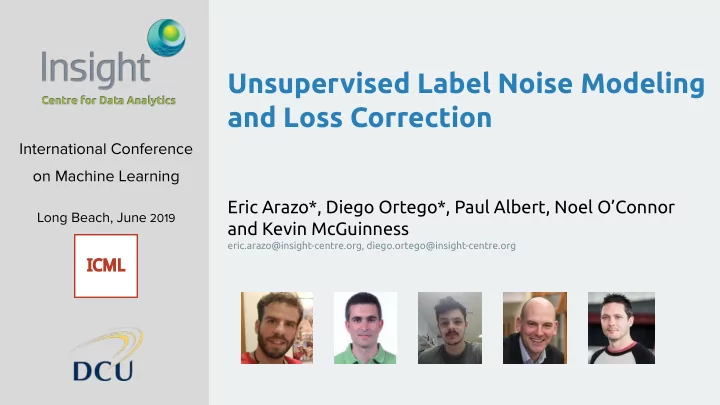

Unsupervised Label Noise Modeling and Loss Correction International Conference on Machine Learning Eric Arazo*, Diego Ortego*, Paul Albert, Noel O’Connor Long Beach, June 2019 and Kevin McGuinness eric.arazo@insight-centre.org, diego.ortego@insight-centre.org
Outline Motivation ● ● Observations Proposed method ● ○ Label noise modeling Loss correction approach ○ ● Results
Motivation: why label noise? ● Top performing DNN models: strong supervision Labeled data is a scarce resource ● ● Several alternatives to relax strong supervision 3
Motivation: why label noise? ● Top performing DNN models: strong supervision Labeled data is a scarce resource ● ● Several alternatives to relax strong supervision Data Semi-supervised learning Unlabeled Labeled 4
Motivation: why label noise? ● Top performing DNN models: strong supervision Labeled data is a scarce resource ● ● Several alternatives to relax strong supervision Data Automatic labeling (label noise) Incorrectly labeled Correctly Labeled 5
Observations ● “Deep neural networks easily fit random labels” [1] CIFAR-10 Source: [1] [1] Zhang et al., “Understanding Deep Learning Requires Re-thinking Generalization”, ICLR 2017. 6
Observations ● Noisy samples take longer to learn ○ “Simple patterns are learned first” [2] ○ “Small loss” [3] ○ “High learning rate prevents memorization [4]” CIFAR-10 Loss 80% label noise Uniform label noise Epoch [2] Arpit et al., “A Closer Look at Memorization in Deep Networks”, ICML 2017. [3] Yu et al., How does disagreement help against label corruption?, ICML 2019 7 [4] Tanaka et al., “Joint Optimization Framework for Learning with Noisy Labels”, CVPR 2018.
Label noise modeling ● Before label noise memorization: clean and noisy samples are (to some extent) distinguishable in the loss ● Two-component mixture model suits the problem Loss 8 Epoch
Label noise modeling ● Before label noise memorization: clean and noisy samples are (to some extent) distinguishable in the loss ● Two-component mixture model suits the problem Loss 9 Epoch
Label noise modeling ● Before label noise memorization: clean and noisy samples are (to some extent) distinguishable in the loss ● Two-component mixture model suits the problem Loss 10 Epoch
Label noise modeling ● Before label noise memorization: clean and noisy samples are (to some extent) distinguishable in the loss ● Two-component mixture model suits the problem Loss 11 Epoch
Loss correction approach ● Bootstrapping loss correction [5] + mixup data augmentation [6] [5] Reed t al. “Training deep neural networks on noisy labels with bootstrapping”, ICLR 2015. [6] Zhang et al., “mixup: Beyond Empirical Risk Minimization”, ICLR 2018. 12
Loss correction approach ● Bootstrapping loss correction [5] + mixup data augmentation [6] Our Beta Mixture Model drives our learning approach a step further by: ● ○ Preventing memorization Correcting noisy labels to learn from them ○ [5] Reed t al. “Training deep neural networks on noisy labels with bootstrapping”, ICLR 2015. [6] Zhang et al., “mixup: Beyond Empirical Risk Minimization”, ICLR 2018. 13
Loss correction approach ● Standard training (left) vs proposed training (right) Loss Epoch Epoch CIFAR-10, 80% label noise, uniform label noise 14
Loss correction approach ● Original labels training (left) vs predicted labels after training (right) 15
Results CIFAR-10 results Code on github: https://git.io/svE 16
For more details and discussions... Come to our poster! (Pacific Ballroom #176) Thanks! 17
Recommend
More recommend